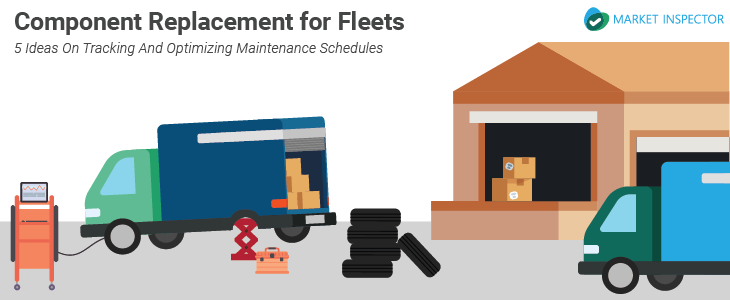- Market-Inspector.co.uk
- Blog
- Fleet Maintenance
Component Replacement For Fleet Maintenance

5 Ideas On Tracking And Optimizing Fleet Maintenance Schedules
Maintenance is an integral part of commercial fleet operations that requires proper planning and execution. It involves a series of proactive and corrective activities that facilitate safe, affordable and predictable utilization of moveable assets.
The scale of maintenance activities varies depending on the size and heterogeneity of a company’s fleet. An effective fleet maintenance strategy should accommodate both planned and emergency schedules.

Companies need to track several variables for them to optimize fleet maintenance programs. Some of the vital maintenance metrics are:
Fleet maintenance is an investment with multiple benefits to a business. Proper maintenance increases the safety and reliability of vehicles, thereby minimizing downtime. It also improves compliance to statutory and environmental regulations, enhances fuel efficiencies and extends the life of an asset.
The European and UK fleet management market is on an upward growth trajectory. Here are tips for strengthening fleet maintenance tracking and schedules.
1. Invest in Technological Solutions
Modern technology is revolutionizing fleet management, with the adoption of fleet technology increasing by 8%. Through telematics, fleet management companies can remotely monitor the locations of vehicles, driving behaviour, fuel consumption and the general health of the assets.
Telematics is a comprehensive technology that incorporates several sensors, communication networks and software. These systems collect and relay information in real-time, providing fleet managers with crucial insights for maintenance planning.
Global Positioning Systems (GPS tracking) utilize geofencing to indicate the exact geographical location of vehicles. Several condition-monitoring sensors monitor driving activity and keep detailed logs. Modern telematics systems have engine diagnostic tools to analyse the conditions of engines, transmission systems and other internal components. Drivers can view this information on the dashboard and is transmitted through dedicated networks to central data management hubs for storage and analysis.
Aside from vehicle tracking, telematics solutions play a role in maintenance. Fleet managers gain remote access to daily vehicle inspection records and accurate mileage information to create preventive maintenance plans. Assets due for maintenance are re-routed based on GPS locations to the nearest service centres for timely repair.
Maintenance teams analyse diagnostic data to detect early signs of component failure and devise a plan for eliminating them before they cripple fleet operations. In case of breakdowns, maintenance technicians analyze diagnostic data and trip logs to identify the interdependence of events leading to asset breakdown.
2. Standardize Maintenance Checklists
Maintenance schedules are business-specific and are developed by considering individual assets in a fleet. Businesses rely heavily on preventive maintenance happening at specific intervals (hours of equipment use or mileage).
Each original equipment manufacturer recommends maintenance intervals. In practice, businesses modify vehicles to suit business needs and asset utilization rates. It is prudent to tailor maintenance schedules to accommodate emergency breakdowns.
Checklists contain information on critical inspection and maintenance points. They provide guidelines for replacing used components. Businesses can create pre-work inspection checklists for operators to fill in and report potential technical defects. How does standardizing maintenance checklists improve fleet maintenance?
Businesses can improve the integrity and accessibility of standard maintenance checklists by distributing them on digital platforms. That way, the company can store vast amounts of data and speed up analysis and visualization.
3. Implement a Suitable CMMS Solution
Investing in a suitable Computerized Maintenance Management System (CMMS) is becoming inevitable across industries. It is a solution that unifies staff, data, tool and spare parts management to enable companies to gain visibility over a dispersed asset base.
For a start, a reliable CMMS system allows a company to optimize maintenance schedules for the entire fleet. These platforms contain information about each piece of equipment, its maintenance intervals, a list of recommended replacement parts, manufacturer manuals and detailed maintenance history.
CMMS programs generate maintenance alerts and distribute maintenance workloads among technicians. Businesses use CMMS platforms to create work requests and approve work orders. These platforms contain standard procedures that maintenance teams follow when maintaining specific equipment. Businesses depend on CMMS programs to analyse onboard sensor data and draw critical maintenance conclusions.
By investing in a CMMS program, a company manages all maintenance activities at the tap of a finger. Managers can monitor the quantity and quality of fleet maintenance work irrespective of an equipment’s physical location. They can peruse maintenance records to track the usage of replacement components, evaluate maintenance costs and monitor vital fleet maintenance metrics.
4. Continuously Review Your Fleet Maintenance Strategy
Fleet management strategies evolve with technology and prevailing market conditions. At the age of sustainability, manufacturers are focusing on energy-saving, autonomous and intelligent fleets. It automatically transforms maintenance practices.
Businesses are steadily adopting predictive maintenance by installing appropriate condition-monitoring sensors to track the life-cycle performance of equipment. They continuously analyse fuel consumption, quality of engine oils, emission levels and wear of components. Technicians check sensor data for anomalies and attend to them in advance.
Artificial intelligence is flourishing and has made entry into the fleet management market. At its basic, the technology provides driving assistance. However, some manufacturers have made progress with the first generation of driverless vehicles.
Aside from improving supply chain stability, AI is bound to disrupt maintenance schedules and tracking. Companies need to keep abreast with these technologies and train their maintenance personnel to undertake hardware and software maintenance of the advanced fleet.
5. Streamline Maintenance Inventories
The overall goal of fleet management is to minimize operations and maintenance costs to improve the profitability of businesses. One of the cost-cutting measures is keeping a lean maintenance inventory.
Each company has to guarantee sufficient availability of supplies to facilitate quick maintenance of the fleet. Each business has to gather accurate information on the number of replacement parts for each piece of equipment. They also need to track the quality of each spare part based on their length of service or rates of failure.
Companies should segregate maintenance supplies based on their criticality, cost of acquisition and frequency of use. They can enlist the services of a 3rd party vendor to avoid stock-holding risks.
Importance of Fleet Maintenance
Fleet maintenance is a continuous process that spans the lifetime of an individual asset. Access to accurate data is becoming inevitable as companies seek to improve the profitability of commercial fleet management. Optimizing maintenance tracking and scheduling requires businesses to leverage technology to improve the quality of maintenance data. They have to evaluate emerging technological trends and adjust their operations to remain competitive and control maintenance costs.

Bryan Christiansen is the founder and CEO of Limble CMMS. Limble is a modern, easy-to-use mobile CMMS software that takes the stress and chaos out of maintenance by helping managers organize, automate, and streamline their maintenance operations.
We strive to connect our customers with the right product and supplier. Would you like to be part of Market Inspector?





